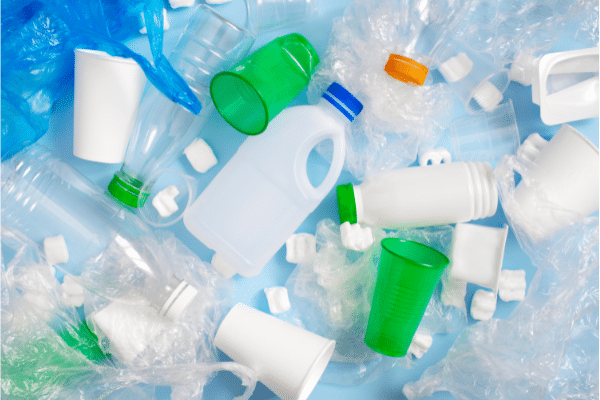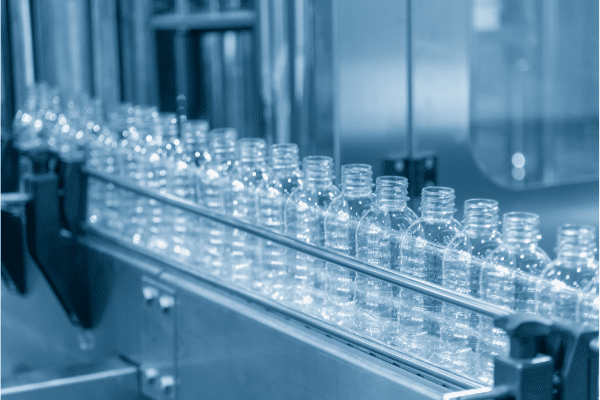Polymers have revolutionized the materials industry and lowered the cost of end products. In this article, we explain the different types of plastic materials most commonly used, their properties and uses.
What are plastics?
One of the major innovations of the 20th century was the introduction and development of plastic materials and their use in many applications, both industrial and everyday, that previously relied on traditional materials such as metal, glass or ceramics.
Plastic is a lightweight, durable, inexpensive and easy-to-modify material. It is made up of polymers, which are large organic molecules composed of repeating carbon units or chains called monomers, such as ethylene, propylene, vinyl chloride and styrene.
Monomers are obtained from petroleum and fossil fuels, or from biomass in the case of bioplastics, and determine the basic properties, structure and size of polymers. However, the manufacturing process also involves additive substances that modify, optimize and improve the properties of the plastics. For example, they improve the flexibility or durability of the polymer, the resistance to UV degradation and combustion, or add color.
Classification of plastic materials
In general, plastic materials can be divided into thermoplastics and thermosets. When heated, thermoplastic components can be repeatedly molded and deformed, whereas thermoset materials cannot be remolded after formation. Thermoplastics are most common and include, among others, polyethylene (PE), polypropylene (PP), polyethylene terephthalate (PET), polyvinyl chloride (PVC) and polystyrene (PS). Some thermosetting plastics are polyurethane (PUR) and epoxy resins or coatings.

The following is a classification of the most common plastics:
1. Polyethylene terephthalate (PET or PETE):
PET is one of the world’s most widely produced plastic materials. It is considered safe for food and beverages and has a high capacity to prevent oxygen from penetrating the packaging and spoiling food. It is a highly recyclable, inexpensive, strong plastic with a very good strength-to-weight ratio. It is used to manufacture food packaging, plastic bottles and polyester fiber such as that found in clothing. It is also used in a wide variety of industrial applications, including the manufacture of fiberglass and carbon nanotubes.
2. Polyethylene (PE):
It is the most common plastic on earth and can be manufactured in different densities. Each density gives the final plastic unique physical properties. As a result, polyethylene is found in a wide range of products.
-
Low Density Polyethylene (LDPE)
LDPE has high ductility, but low tensile strength, making it more flexible than other plastics. It is used to manufacture products such as plastic bags, transparent food packaging, disposable packaging and cable insulation, among others.
-
Medium density polyethylene (MDPE)
Having more polymer chains and therefore higher density, medium density polyethylene is often used in gas pipes, shrink film, carrier bags and screw caps.
-
High Density Polyethylene (HDPE)
HDPE is considered environmentally friendly, and the manufacture of this type of plastic requires only a small fraction of the energy that would be needed to produce steel from iron ore. It is a plastic that is resistant to degradation, environmental agents and is quite rigid, which is why it is used to manufacture a multitude of products, such as material containers, buckets, signage, sprockets, water and sewer pipes.
-
Ultra High Molecular Weight Polyethylene (UHMWPE)
UHMWPE is characterized by high density and abrasion resistance due to the extreme length of its polymer chains. Possessing high density, strength and low friction properties, it is used in military armor, seals, hydraulic bearings and biomaterials such as medical prosthetic implants.
3. Polypropylene (PP)
Polypropylene is a very hard, heat-resistant, semi-transparent plastic that retains its shape after much twisting, bending or folding. Its widespread use and popularity are undoubted, as it is one of the most flexible thermoplastic polymers on the planet. Durable, flexible, heat-resistant, acid-resistant and inexpensive, polypropylene sheet is used to manufacture laboratory equipment, automotive parts, hinges, medical devices and food packaging, among others.
4. Polycarbonate (PC)
Strong, stable and transparent, polycarbonate is an excellent engineering plastic as clear as glass and two hundred and fifty times stronger. Clear polycarbonate sheets are easy to work with, easy to shape and, although extremely strong and impact resistant, polycarbonate plastic has an inherent design flexibility. It is found in a wide variety of products, such as greenhouses, DVDs, sunglasses, riot gear, etc.
5. Polyvinyl Chloride (PVC)
PVC is a polymer that possesses rigid or flexible properties and is well known for its ability to blend with other materials. For example, expanded PVC sheet is a foamed polyvinyl chloride material that is ideal for products such as kiosks, store displays and exhibits. The rigid form of PVC is commonly used in building materials, doors, windows, flooring, cladding, etc. With the addition of plasticizers such as phthalates, the softer, more flexible form of PVC is found in plumbing products, electrical cable insulation, clothing, medical tubing and other similar products.
6. Polystyrene (PS)
This is a transparent thermoplastic that can be found in both solid plastic and rigid foam material. The use of polystyrene is widespread and is used in packaging, medical devices such as test tubes or Petri dishes, polystyrene foam peanuts, parts of household appliances, automobiles and computers, among others. In industry it is especially used to manufacture sprockets for roller chains, rod saddles or pulleys.
Polymer Testing
Testing plays a key role in the life cycle of a polymer, from raw material through compound to final product. Each stage has different testing requirements, and may require a different type of test depending on its utility, whether in product development, quality control, material characterization, property testing or forensic engineering analysis for failure identification.
Some of the most common tests that plastic materials are subjected to are:
- Mechanical tests, such as tensile, flexure, shear and compression.
- Physical tests, which include density, hardness and scratch resistance tests.
- Rheological tests, including capillarity, rotation or melt flow rate tests.
- Thermal tests.
- Optical tests.
- Climatic tests.
In short, the wide variety of product types and additives available makes understanding the capabilities and limitations of a material a key issue for suppliers, manufacturers and product developers at all levels of the industrial chain. Mechanical, thermal, optical, rheological behavior and climatic testing provide a better understanding of material, product and performance.
If you are looking for an integrated approach to help you meet the performance specifications of your products, our combined experience and testing expertise will give you the help you need. Contact us and our experts will analyze your case to offer you the best solution.





